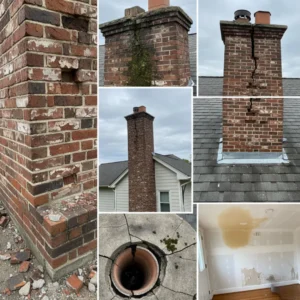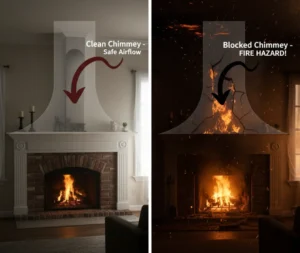A fireplace is a source of comfort, a place where families gather for warmth and relaxation. But for millions of people living with respiratory issues like asthma, allergies, or COPD, that source of comfort can become a hidden source of irritation. When a chimney is not properly maintained, it can directly and negatively impact your home’s indoor air quality, turning a cozy night in, into a trigger for coughing, wheezing, and other symptoms.
Most homeowners associate chimney maintenance with a single danger: chimney fires. While preventing fires is a critical reason for a chimney sweep & cleaning service, it is not the only one. For households with respiratory sensitivities, the everyday health hazard of a dirty chimney can be a more immediate and persistent problem.
A clean chimney is not just a fire safety issue. It is a health issue. Here is a detailed look at how your chimney system affects your breathing and why professional cleaning is essential for a healthy home.
The Hidden Pollutants in Your Chimney
A chimney is an exhaust system. Over time, its inner walls become coated with a complex cocktail of substances. These pollutants do not always stay inside the flue. They can and do find their way into your home’s living space.
Here is what is lurking inside a dirty chimney:
Fine Particulate Matter (Soot): Soot is not just a black powder. It is primarily composed of fine and ultrafine particulate matter (PM2.5). These microscopic particles are so small they can bypass your body’s natural defenses, embedding deep in the lungs. For a person with asthma, these particles are a powerful irritant that can cause inflammation and trigger a severe attack.
Creosote Fumes: Creosote is the tarry, flammable substance that all wood fires create. Even when a fire is not lit, these chemical deposits can off-gas, releasing a smoky, acrid odor into your home. These fumes can be a constant irritant for sensitive lungs.
Mold and Mildew: Chimneys are highly susceptible to moisture, especially if the chimney cap is missing or the masonry is cracked. A water leak repair is often needed for chimneys that have been neglected. This damp, dark environment is a perfect breeding ground for mold and mildew. Mold spores are one of the most common and potent indoor allergens, and they can be pulled into your home’s air, triggering allergic reactions and asthma.
Animal Dander and Droppings: An uncapped chimney is an open invitation for birds, raccoons, and rodents. These animals build nests and leave behind dander and droppings. These waste products are powerful biological allergens that can become airborne and circulate through your home, causing significant respiratory distress. A proper chimney cap installation & repair is the only permanent solution to this.
How These Pollutants Enter Your Living Space
You might think that as long as the fireplace is not in use, these pollutants stay in the chimney. Unfortunately, that is not how airflow works.
1. Back-Puffing and Poor Draft (When a Fire is Lit)
The most obvious problem is a blocked chimney. A flue that is clogged with creosote, a bird’s nest, or other debris cannot “draw” air properly. When you light a fire, the smoke and all its particulate matter have nowhere to go but back down the chimney and into your room. This “back-puffing” is a clear sign your chimney is dangerously clogged and is actively pumping your air full of lung-damaging particles.
2. Negative Pressure (When the Fire is Out)
This is the more silent and less-known issue. Your home is a complex pressure system. When you run an exhaust fan in your kitchen, a bathroom fan, or a clothes dryer, you are pumping air out of your house. This creates “negative pressure.” Your home will try to balance this by pulling “make-up” air from the easiest source. That source is often your chimney.
This means that even on a summer day with no fire, your home could be sucking air down your dirty chimney. That air brings with it all the soot, mold spores, animal dander, and creosote fumes, distributing them invisibly throughout your entire home.
3. Carbon Monoxide (CO) Leaks
A blocked or damaged chimney is not just an irritant; it is a deadly hazard. Carbon monoxide (CO) is a colorless, odorless gas produced by all combustion. A clean, sound chimney vents it safely outside. But if the flue is blocked or has cracks, this gas can leak into your home. While CO is dangerous for everyone, it is especially critical for those with COPD or heart conditions, as it displaces oxygen in the bloodstream, putting immense strain on an already-compromised system.
How Professional Cleaning Protects Your Respiratory Health
A professional chimney cleaning is a health service. It is the most effective way to remove these threats at their source.
Total Pollutant Removal: Our technicians use specialized rotary brushes and high-powered vacuums to scrub the flue from top to bottom. This removes not only the flammable creosote but also the particulate matter, mold, and allergenic animal waste.
The “No Mess, No Dust” Process: This is a major concern for anyone with respiratory issues. The last thing you want is a cloud of soot in your living room. We take meticulous precautions. Our technicians use industrial-grade HEPA-filter vacuums and seal off the fireplace opening. This ensures that all the dust, soot, and allergens are captured in our containment system, not released into your home’s air.
Restoring Proper Draft: By clearing all obstructions, we restore your chimney’s proper draft. This stops back-puffing and ensures that when you do use your fireplace, the smoke and particles go up the flue, not into your lungs.
An annual chimney inspection is just as important. During an inspection, our experts can spot problems that lead to air quality issues, such as a cracked flue liner that could be leaking gases or a damaged chimney crown that is letting in mold-causing water. Identifying these issues early is key to preventing long-term air quality problems and the need for a major chimney repair.
For families with respiratory sensitivities, a clean chimney is not a luxury. It is a vital component of a healthy indoor environment. You cannot have clean air in your home if your chimney is dirty.
Your family’s health is too important to risk on a dirty flue. If you or a loved one suffers from asthma, allergies, or other breathing issues, take a critical step toward cleaner indoor air. The certified professionals at Texas Chimney LLC provide a no-mess, comprehensive cleaning that removes the hidden pollutants in your chimney. Contact us today to schedule your service and breathe easier this season.





